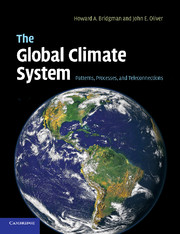Book contents
- Frontmatter
- Contents
- List of contributors
- Preface
- List of abbreviations
- 1 Introduction
- 2 Oscillations and teleconnections
- 3 Tropical climates
- 4 Middle-latitude climates
- 5 Climate of the polar realms
- 6 Post-glacial climatic change and variability
- 7 Urban impacts on climate
- 8 Human response to climate change
- 9 ESSAY: Model interpretation of climate signals: an application to Asian monsoon climate (Lau)
- 10 Conclusions and the future of climate research
- Other books on climatology and the climate system
- Index
- Plate section
- References
2 - Oscillations and teleconnections
Published online by Cambridge University Press: 05 June 2012
- Frontmatter
- Contents
- List of contributors
- Preface
- List of abbreviations
- 1 Introduction
- 2 Oscillations and teleconnections
- 3 Tropical climates
- 4 Middle-latitude climates
- 5 Climate of the polar realms
- 6 Post-glacial climatic change and variability
- 7 Urban impacts on climate
- 8 Human response to climate change
- 9 ESSAY: Model interpretation of climate signals: an application to Asian monsoon climate (Lau)
- 10 Conclusions and the future of climate research
- Other books on climatology and the climate system
- Index
- Plate section
- References
Summary
History and definitions
The concept of atmospheric oscillation began with studies of the Asian monsoon. Following the great 1877 drought in India, the India Meteorological Department was established under the leadership of H. F. Blanford. His task, in part, was to examine whether any monsoon seasonal prediction could be identified. Concentrating upon solar relations and climate, he could not report success. It was, however, Sir Gilbert Walker who, as Director-General of Observatories in the India Meteorological Department, initiated extensive studies of pressure patterns that eventually led to the identification of atmospheric oscillations. After he retired in 1924, Walker observed a see-saw like oscillation of sea level pressures in various parts of the Pacific Ocean (Walker 1923–4). He labeled this the Southern Oscillation. Further studies in the 1920s and 1930s saw identification of North Atlantic and North Pacific oscillations. Not a great deal of attention was accorded this work, and it was not until many years later that the contribution of Walker was recognized and the Walker circulation named in his honor (Bjerknes 1966). It is interesting to note that the statistical methods used by Walker were sophisticated enough to become the “Yule–Walker equations” that refer to properties satisfied by the autocorrelations of an autoregressive process (Katz 2002).
Throughout this text the discussion of regional climates and anomalies will, in part, concern teleconnections. This chapter provides a background to the major oscillations that relate to teleconnections.
- Type
- Chapter
- Information
- The Global Climate SystemPatterns, Processes, and Teleconnections, pp. 25 - 58Publisher: Cambridge University PressPrint publication year: 2006



